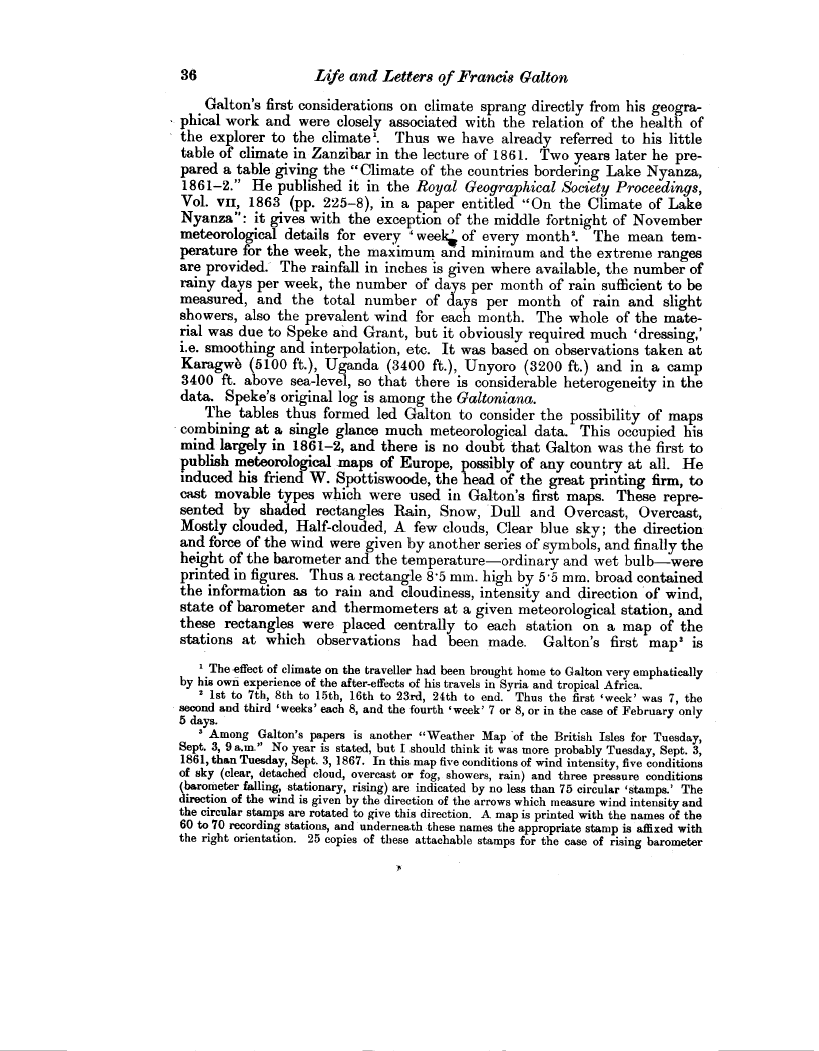36 Life and Letters of Francis Galton
Galton's first considerations on climate sprang directly from his geographical work and were closely associated with the relation of the health of the explorer to the climate'. Thus we have already referred to his little table of climate in Zanzibar in the lecture of 1861. Two years later he prepared a table giving the "Climate of the countries bordering Lake Nyanza, 1861-2." He published it in the Royal Geographical Society Proceedings, Vol. vii, 1863 (pp. 225-8), in a paper entitled "On the Climate of Lake Nyanza": it gives with the exception of the middle fortnight of November meteorological details for every `week of every month'. The mean temperature for the week, the maximum and minimum and the extreme ranges are provided." The rainfall in inches is given where available, the number of rainy days per week, the number of days per month of rain sufficient to be measured, and the total number of days per month of rain and slight showers, also the prevalent wind for each month. The whole of the material was due to Speke and Grant, but it obviously required much `dressing,' i.e. smoothing and interpolation, etc. It was based on observations taken at Karagwe (5100 ft.), Uganda (3400 ft.), Unyoro (3200 ft.) and in a camp 3400 ft. above sea-level, so that there is considerable heterogeneity in the data. Speke's original log is among the Galtoniana.
The tables thus formed led Galton to consider the possibility of maps combining at a single glance much meteorological data. This occupied his mind largely in 1861-2, and there is no doubt that Galton was the first to publish meteorological -maps of Europe, possibly of any country at all. He induced his friend W. Spottiswoode, the head of the great printing firm, to cast movable types which were used in Galton's first maps. These represented by shaded rectangles Rain, Snow, Dull and Overcast, Overcast, Mostly clouded, Half-clouded, A few clouds, Clear blue sky; the direction and force of the wind were given by another series of symbols, and finally the height of the barometer and the temperature-ordinary and wet bulb-were printed in figures. Thus a rectangle 8.5 mm. high by 5.5 mm. broad contained the information as to rain and cloudiness, intensity and direction of wind, state of barometer and thermometers at a given meteorological station, and these rectangles were placed centrally to each station on a map of the stations at which observations had been made. Galton's first map' is
1 The -effect of climate on the traveller had been brought home to Galton very emphatically by his own experience of the after-effects of his travels in Syria and tropical Africa.
2 1st to 7th, 8th to 15th, 16th to 23rd, 24th to end. Thus the first 'week' was 7, the second and third 'weeks' each 8, and the fourth 'week' 7 or 8, or in the case of February only 5 days.
s Among Galton's papers is another "Weather Map *of the British Isles for Tuesday, Sept. 3, 9 a.m." No year is stated, but I should think it was more probably Tuesday, Sept. 3, 1861, than Tuesday, Sept. 3, 1867. In this map five conditions of wind intensity, five conditions of sky (clear, detached cloud, overcast or fog, showers, rain) and three pressure conditions (barometer falling, stationary, rising) are indicated by no less than 75 circular 'stamps.' The direction of the wind is given by the direction of the arrows which measure wind intensity and the circular stamps are rotated to give this direction. A map is printed with the names of the 60 to 70 recording stations, and underneath these names the appropriate stamp is affixed with the right orientation. 25 copies of these attachable stamps for the case of rising barometer

